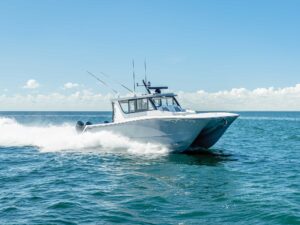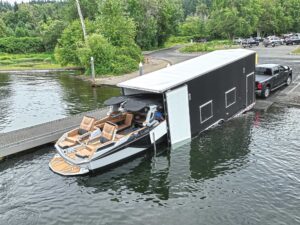
“Dad, it doesn’t fit and it looks dorky,” were not the words I wanted to hear from my son after tossing him his lifejacket and turning away to wrestle my own vest from the wad of PFDs aboard the family pontoon boat. The assortment of faded kapok- and foam-filled jackets had been stashed beneath the boat’s bench seat during the long off-season, and upon gazing at Ethan it was apparent that he had grown a bit since he had last donned the device, which resembled a blaze-orange yoke on the boy rather than a functional flotation vest.
It quickly became apparent that his off-season growth included more than girth; when I handed my son a slightly larger PFD from the musty-smelling collection he refused to don the device, pointing out its colorful “Bob the Builder” theme, apparently a cartoon association he that he had also outgrown over the course of the off-season.
At that point I did what any conscientious parent of a grade-schooler would: I used the promise of fast food and extra TV time to bribe him into wearing the floating fashion faux pas so that we could cast off and legally enjoy the season’s first day of fishing without first having to shop for a new vest.
READ MORE: Boating Safety Tip Articles
When we did get around to selecting for my son a PFD worthy of his new-found physical and social stature, frankly I was floored by the variety available. As somewhat of a boating professional, I pride myself in being on the cutting edge when it comes to what’s new in boats and accessories, but after a little web-surfing and gawking at the wall full of PFDs at my local West Marine it became obvious that I had overlooked the advances made in what I date myself by still calling “life jackets.”
I spent less time choosing and fitting the tux I got married in than the two of us devoted to picking out my kid’s PFD for the coming season. Once I got to the adult section I found the selection almost as varied in size and style and every bit as bright on the eyes. In addition to offering a palate to complement any craft’s color theme, there are specific styles of PFDs designed for fishing, wakeboarding, waterskiing, surfing and even wading – not to mention youth models depicting images of every popular cartoon character since Popeye. Most adult categories even include inflatable models fueled by CO2 that deploy automatically.
To get myself back up to speed on the PFD phenomenon, I called Stearns, which offers a one of the largest lines of life vests in the industry, to learn about the latest life jacket innovations and trends.
From the Stern’s spokesman I found out that in addition to a huge variety of colors, patterns, sizes and styles available in modern PFDs, “end use functionality” is a key term among life-vest designers a present, which is achieved by adding special features to PFDs that are intended for use by individuals participating in a particular water-based activity.
BOATINGLAB: Auto-Inflatable PFDs
Five functional features you are likely to find on today’s PFDs include:
-Stretchability, which is especially important for active watersports enthusiasts who need their vests to be form-fitting but flexible while remaining comfortable.
-Air Flow Capabilities, which allow the wearer to remain cool and/or dry for added comfort.
-Ergonomic Fit, which is gained through the addition of more seams for a tailored fit and more seam panels to make the foam less cumbersome
-Integration, which includes models for children that combine PFD flotation features with swim suits
-Inflatability, a fast-growing category that allows belt-, purse- or suspender-style PFDs to offer US Coast Guard Approved flotation capabilities in models that use replaceable CO2 cartridges to inflate manually — or even automatically upon exposure to moisture.
The gas-charged option may sound a bit too “high tech” for those of us who still depend on traditional kapok to keep us afloat. However, the auto-inflate models are nothing to be sneezed at.
VIDEO: Inflatable PFD Dunk Tank Test
BONUS: PFD Fitness Test
The United States Coast Guard recommends the following test to determine proper fit of a PFD:
— Match the wearer’s body size to the proper size PFD. USCG-approved flotation devices come in different size ranges based on body weight, which are usually printed on the labeling.
— Securely close all fasteners on the PFD. Have someone grasp the PFD shoulder openings from behind and pull firmly upward. The PFD should remain snug with minimal shifting.
— When testing small childrens’ PFD fit, lift in the same manner, to the point of lifting the child off the ground. If the PDF slips off, covers the wearer’s mouth or nose, it is not a proper fit and needs to be tightened or a smaller PFD needs to be used.
— The best place to test PFD performance, particularly for young children, is in a pool or shallow water under close supervision.
— The best PFD is the one you will wear. To learn more about PFDs and safe boating, visit www.uscgboating.org.









